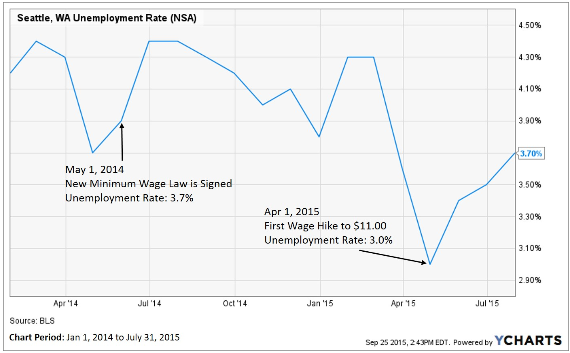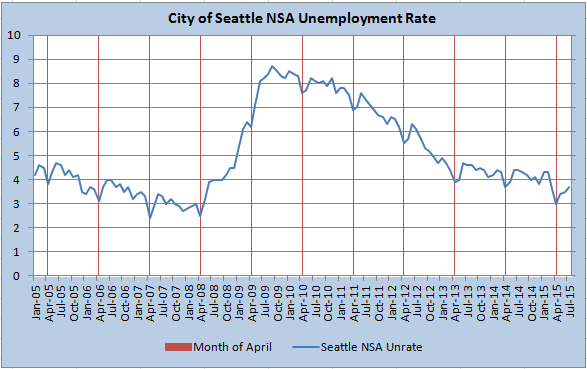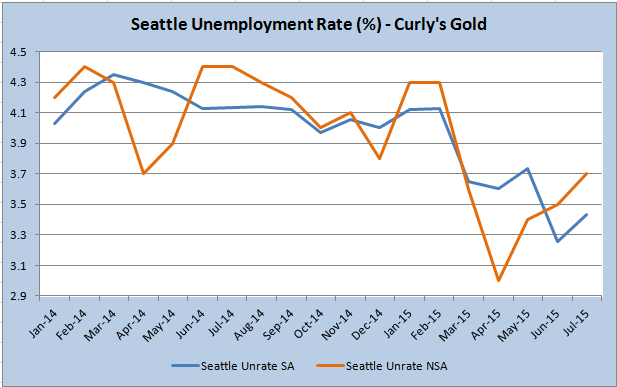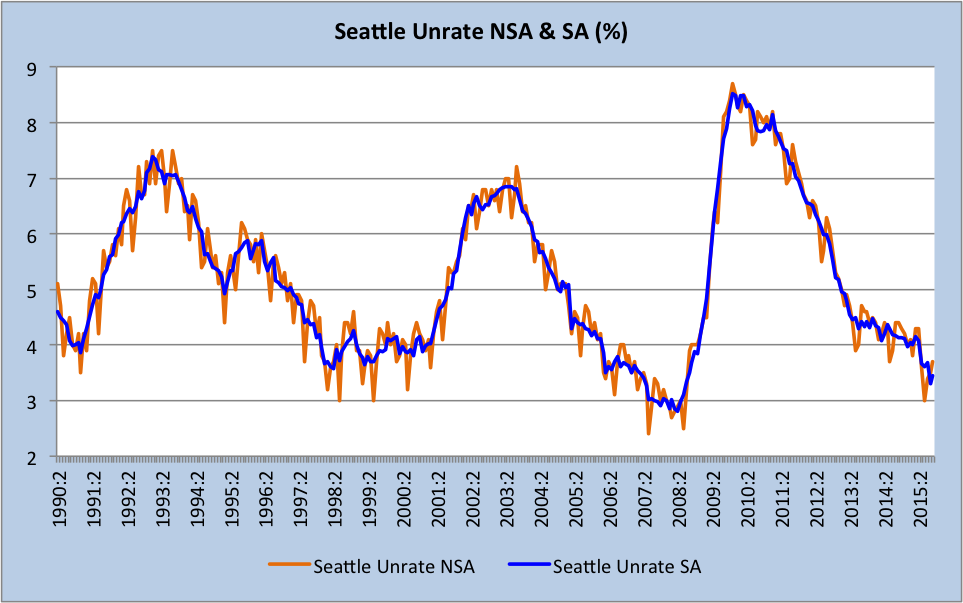@TBPInvictus
Moe and Larry on Seattle’s minimum wage are now joined by Curly, a fellow by the name of Mike Patton, whose recent screed on the topic can be found here.
To demonstrate the deliterious effects of Seattle’s new law, Patton provides us the following chart:
(Let’s disregard the fact that what Patton cites as 3.7% is actually 3.9% (May 2014). We’ll let that slide as an honest error.)
Writes Patton:
The following graph [Ed note: Now above] contains Seattle’s unemployment rate from January 1, 2014 to July 31, 2015. I have marked two important dates and included the unemployment rate at those times. When the law was signed, May 1, 2014, Seattle’s unemployment rate was 3.70%. When the first wage hike occurred, April 1, 2015, unemployment was 3.0%. Since then, unemployment has risen steadily while the national average has trended lower.
The “NSA” in the chart title indicates that the data are not seasonally adjusted. This matters when analyzing data, and we’ll get to that shortly. For now, though, let’s pull back the lens a bit and see what the Seattle unemployment rate (not seasaonally adjusted) looks like over a longer timeframe than that which Patton provided:
(Source: BLS.gov)
For Mr. Patton’s benefit: The reddish vertical lines correspond to the month of April. You know April – it’s the month during which the unemployment rate troughs in Seattle each and every year (as you can clearly see above). In other words, aside from analyzing a ridiculously short timeframe, seasonality tells us that Seattle’s unemployment rate troughs every April. Like clockwork. As if it were, what’s the word, seasonal. That’s what seasonality is all about – recurring patterns or trends, picked up in data, that can be subsequently adjusted.
Below is Mr. Patton’s NSA data – in Curly’s Gold – along with the same data seasonally adjusted (in blue). Although the timeframe is still absurdly short to make any meaningful inferences, we can see that the most recent SA unemployment rate, at 3.43%, is still lower than March’s 3.65% or April’s 3.60%. It is, of course, higher than June’s 3.26% but, seriously, how low can we reasonably expect it to go?
(Source: BLS.gov, Seasonal Adjustment by Census Bureau’s X-13ARIMA-SEATS Seasonal Adjustment Program)
Finally, here’s a longer-term look at the data (from Feb 1990 on) – the jagged sawtooth pattern of the NSA data smoothed out by the seasonal adjustment software. The seasonal annual troughs are clearly visible:
(Source: BLS.gov, Seasonal Adjustment by Census Bureau’s X-13ARIMA-SEATS Seasonal Adjustment Program)
If you can look at the chart above and a) Tell me that you can divine a problem developing with the Seattle unemployment rate and b) Ascribe the root cause of said problem to the April minimum wage hike, well, congratulations, you’re a remarkably astute observer of economics and, apparently, some sort of chart whisperer.
Bottom line: The labor market in Seattle appears fairly tight, with the unemployment rate generally lower than we’ve seen there in almost a decade, since before the Great Recession. That simply cannot last forever. When and why it eventually rises is an open question. One thing, however, is for certain: I’ve yet to see any compelling evidence from the Three Stooges that the city’s new minimum wage is adversely impacting its economy.






In addition to those absurdities there is not rational causation behind the postulates that the minimum wage has scared away employees from hiring people (create new jobs).
If the fear of having to pay a living wage had businesses move out of Seattle you would expect a slow continuos loss of jobs (increase in unemployment) beginning from the time it became obvious that this had a chance of passing (employers thinking I better wait and see with hiring more people) – and intensifying after it passed (employers acting on the sure knowledge of higher wages by failing to create new businesses or moving out old businesses). Even this ridiculously Cherry-picked set of semi-irrelevant data fail to show the gently upward sloping trend one would expect if the increased minimum wage scared away more businesses than it attracted (smart business owners know that people with more income will purchase more products and services so they anticipate and expand).
Of course, you’re right and I appreciate you being on top of this, but for better or worse this “issue” in Seattle has not really been covered anywhere that I’ve seen and I suspect is unknown to most of the population. If those trying to use it to forward their agenda(s) are gauging their success by having it become a popular topic of discussion, they have failed.
But it will be interesting to see how the data plays out and I’m sure you will keep us posted. I’m hopeful that the data remains steady. The alternative would be a race to the bottom for labor and that trend we’ve generally been following for the last 30 years or so is to the detrmiment of US society, growth, and citizen sastisfaction.
The other way to assess this is to show an un annotated chart and ask a unbiased party “Can you spot the point at which the minimum wage law was announced? Was implemented?”
This is for the entire metro area, but
http://www.bls.gov/eag/eag.wa_seattle_msa.htm
employment in leisure and hospitality is up 12k since the new minimum wage went in and the number of unemployed is down 10k.
Nonetheless, it’s entirely too soon to be doing a victory lap. In a hot economy, the natural minimum wage might be in excess of $11/hr (it is in the Bay Area for sure) in which case raising the minimum wage has no effect on employment. I imagine that once the minimum wage exceeds what the labor supply would naturally support, demand for low-skilled workers will fall (unless the law of supply and demand was also repealed by government fiat). Restaurants and retail establishments just over the city border will gain at the expense of restaurants and retail establishments next door. Though, as anyone who has ever been in an In-N-Out [which pays above what other fast food joints pay] will tell you, it will be a much pleasanter shopping experience in Seattle and workers won’t be spitting in your food.
Unemployment in Seattle? If you want a job –
-you could be unloading trucks fulltime starting at $12/hr; in the Tacoma area, way south of Seattle
-daytime parttime janitor, $14-18 DOE, med & dental after 60 days
-auto parts driver in Renton (south of Seattle), fulltime M-F, $10/hr: Paid Vacation, 401k, Paid Medical, Dental, and Vision.